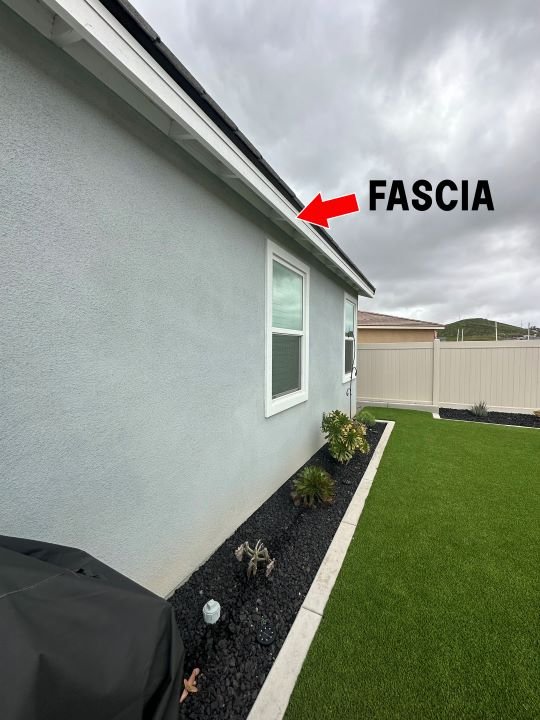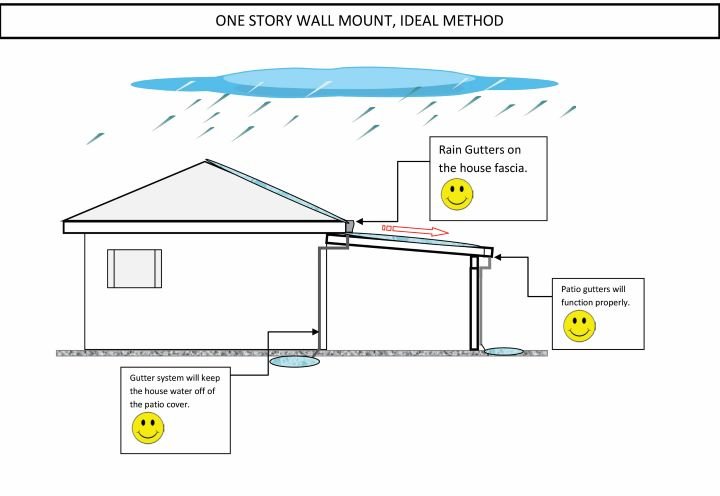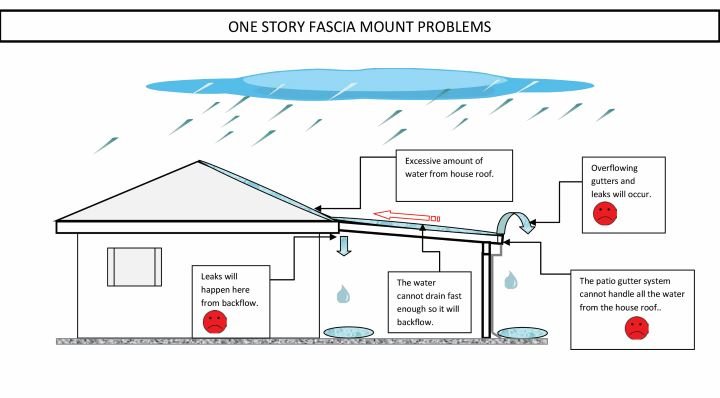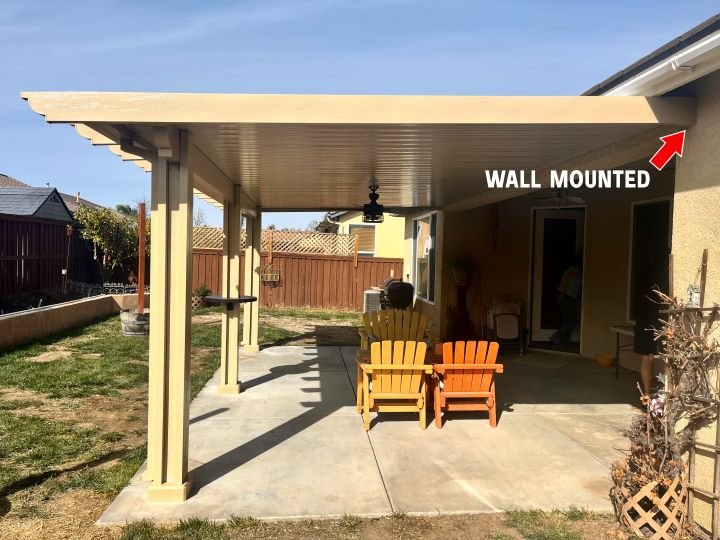
Stucco wall below an aluminum patio cover showing “leaks.”
If you are here, chances are you have experienced this before or recently after getting some rain. This is a common concern we hear and read about with aluminum patio cover homeowners, which is why we would like to address it for you!
In the patio cover industry, this is known as “wet wall”. It is very common, but rest assured it is not a major concern and will not damage your home. We always do our best to inform those who have an aluminum patio cover attached to their home about wet wall if we know it is something they will experience. Wet wall can be caused by a few different factors when you have a patio cover and we will address each one in detail for you.
The biggest culprit of leaks, or wet wall, under your aluminum patio cover, is not having rain gutters on your home. For a two-story home, the water falling from the second story onto the roof of the patio cover will splash back up onto the stucco wall above the patio cover. With stucco being a porous material, any water or moisture will be absorbed by it. Once it starts splashing back up onto the stucco wall, it will then make its way down, through absorption, to the wall below your patio cover. This gives the appearance of your patio cover leaking when it is not. When you have a two-story home that does not have rain gutters and you have an aluminum patio cover installed, you guarantee that you will experience wet wall at some point. 
How Wet Wall Occurs
The engineering of aluminum patio covers such as Alumawood, Duralum, Four Seasons, or United Duralume, was not designed to handle the amount of water that flows off the roof of the home during heavy rain.
This brings us to factor number two for a two-story home. Your aluminum patio cover has its own integrated gutter system but is only meant to handle the water flow of what lands on the patio cover roof itself.
When we experience heavy rainfall, excessive water from the roof of the home falls onto the patio cover and cannot be drained fast enough by the patio cover’s gutter system. It will begin to backflow and get absorbed by the stucco, which will also look as if your patio cover is leaking.
Your aluminum patio cover is attached to the wall and sealed with flashing, but this does not prevent the water from splashing back up onto the stucco or backflow being absorbed; showing the importance of rain gutters.
We strongly recommend if you are considering building an aluminum patio cover for your two-story home, that you install rain gutters beforehand. It will make the process for the installer that much easier and likely cheaper than if they needed to do the install with a patio cover already built, because you cannot stand on top of or use ladders on an aluminum patio cover.

Rain gutters will save you the hassle of experiencing wet wall or leaks.
To elaborate more on how this is not a major concern when it comes to causing damage to your home, the stucco is purely cosmetic. The stucco is not what protects water from leaking into your home and cannot be made 100% waterproof. Multiple waterproof barriers are built behind the stucco to protect your home from water damage.
While we completely agree that wet wall isn’t all that great to look at, you don’t have to worry about it. As in the picture below, it is no different than your home appearing wet or stained towards the bottom where water splashes up onto the stucco wall.
There are products on the market that can make your stucco more water resistant, but be sure to do your due diligence on doing research and finding the correct product!

With stucco being a porous material, it will absorb any water splash up from rain or from rinsing off your patio.
The third factor to consider when installing an aluminum patio cover to your home correlates with one-story homes. One-story homes are different from two-story homes and can sometimes hold more potential headaches when building an attached patio cover and is dependent upon the design of the home.
This factor is when you are required or want to attach the patio cover to the fascia of the house. The fascia board is the long, straight board that runs along the lower edge of the roof. It also is where any rain gutters will be installed.

The fascia board of a home.
In an ideal world, the aluminum patio cover should be attached to the wall just below the fascia, with the fascia having rain gutters installed. The home’s rain gutters will keep the water from running off onto the patio cover, as shown in the diagram below. This allows for the built-in gutter system of your aluminum patio cover to function properly.

Similarly to two-story homes that don’t have rain gutters, a one-story home can also have too much water runoff from the roof that the gutter system of the patio cover cannot handle.
The diagram below shows that when the water starts to backflow with the excessive runoff from the roof, you run into the issue of water leaking through the patio cover where it is attached to the fascia. You will likely also experience water overflowing from the patio cover’s gutters as well.

Here are two examples below showing an aluminum patio cover being attached via wall mount, as well as a fascia mount.


In cases such as the fascia-mounted patio cover above, sometimes contractors are forced to attach your aluminum patio cover to the fascia. On certain designs of one-story homes, there is simply not enough wall space between the fascia and the border molding of windows, doors, or lanai (also known as California rooms) for the patio cover to attach to.
The trim around windows, etc, is actually made of foam board and covered with stucco texture, making it not viable to support your patio cover.
There are a few things that we would recommend doing if a fascia mount is the only way to install the patio cover.
1. Give the patio more tilt than the standard. Build with 1/2" per foot fall.
2. Add more downspouts to the cover to get rid of the water faster. (Will result in extra costs)
3. Build it with a California gutter, which is a larger trough/gutter. This type of rain gutter will hold more water and prevent backflow. (Will result in extra costs)
Even with all of these precautions, the patio may still leak at the fascia depending on the amount of rain and wind together. Houses with no flashing or roof drip edge metal will leak at the fascia 100% guaranteed and your contractor cannot be held responsible.
We hope that by going into all of this in detail, you can make your own informed decision about installing an aluminum patio cover to your home or fixing the issue of wet wall and leaks with your existing patio cover. The benefits a patio cover can provide are exponential; especially during warmer months. But we do understand the need for homeowners to have all of this information available to them so they can decide what is best for them and take the necessary steps.
Until next time!
-Your friends at LB Stuctural Inc.

